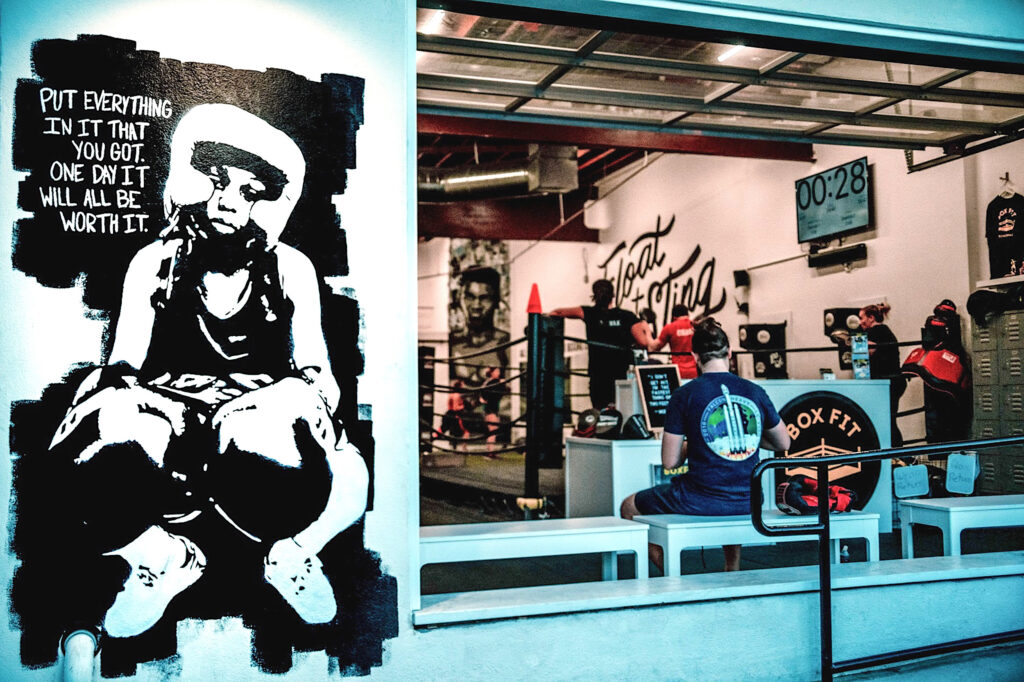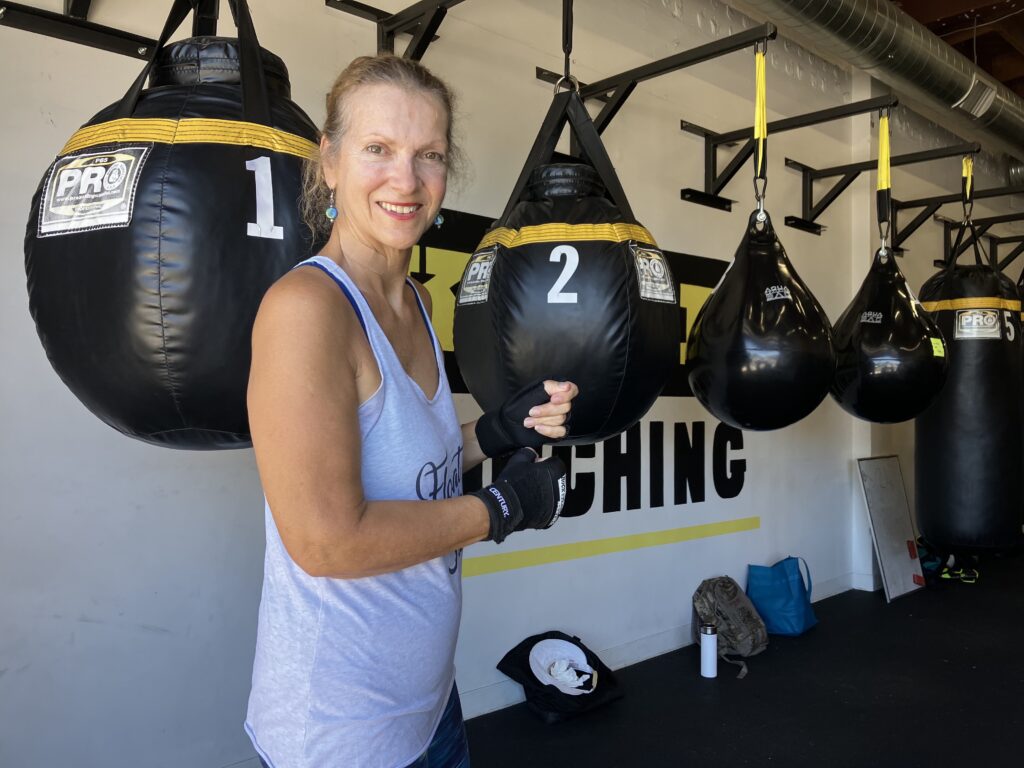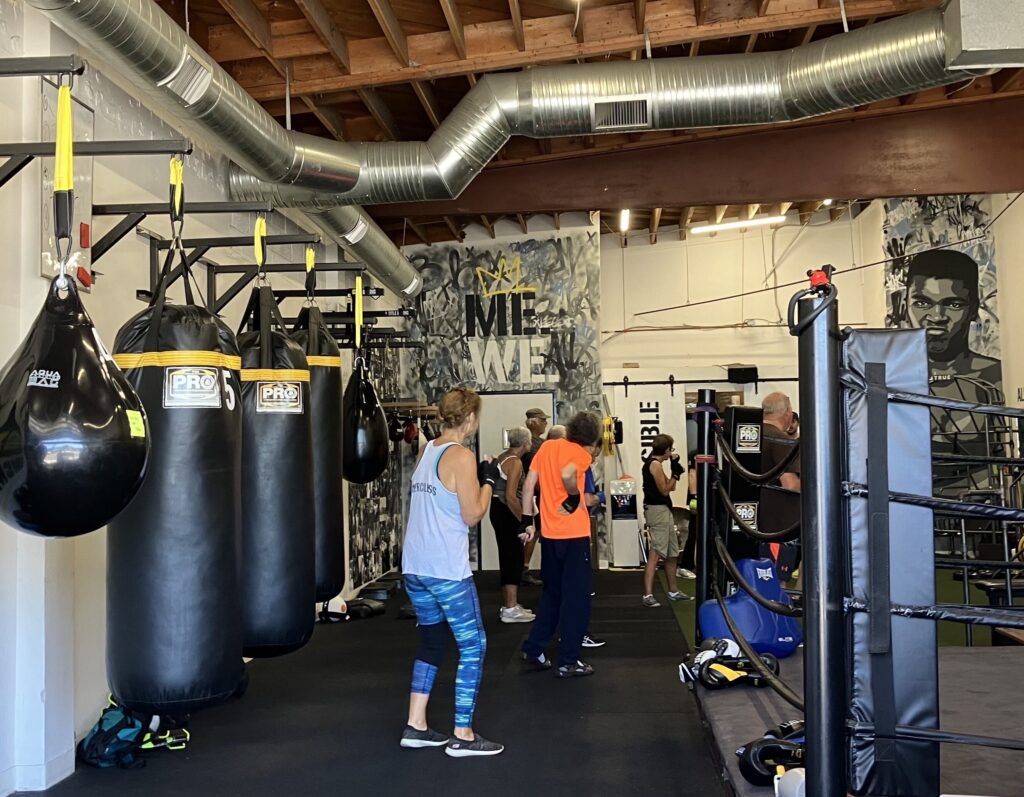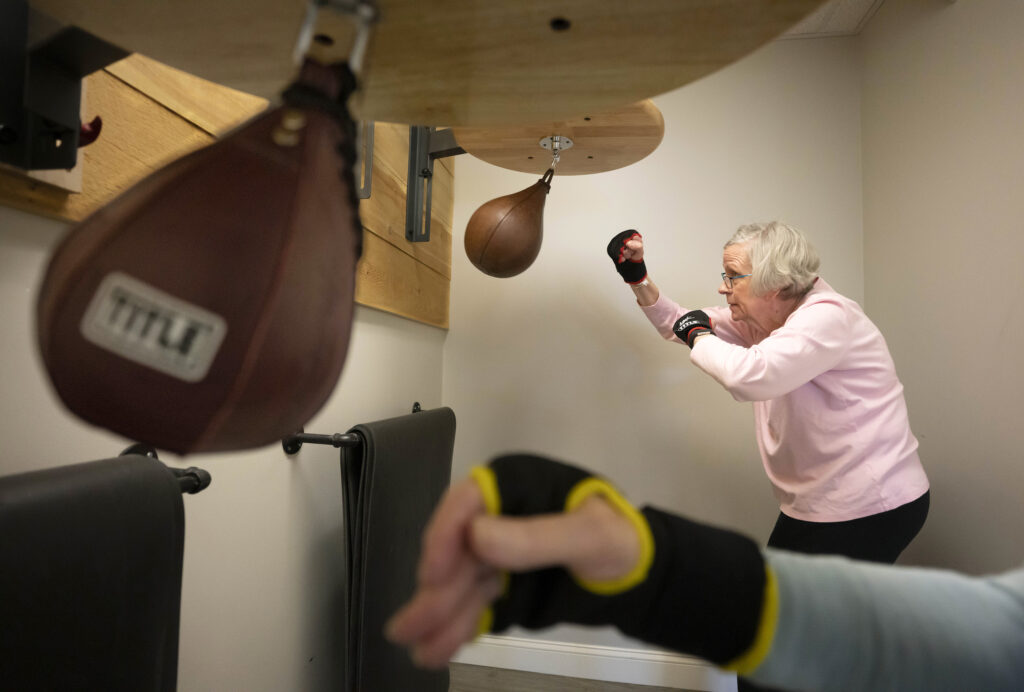Taking on Parkinson’s Disease—With Boxing Gloves and Punching Bags

The smell of Thai food came wafting into the boxing gym from a restaurant across the street. Located in downtown San Diego, the gym storefront’s two large garage doors were rolled open, letting sunshine and breeze spill into the open space. A bell rang out in the gym, and dozens of boxers slowly stopped their workouts.
An exuberant, middle-aged redhead turned toward me, beaming, and asked, “Can you smell that?”
I smiled and nodded before realizing the peculiarity of her question. “Wait … you can smell that?” I asked.
Moxie (a pseudonym) could not usually smell anything at all—a symptom of Parkinson’s disease.
“Sometimes after a little while boxing, I can smell again,” she said, smiling as she took off her gloves.
Others in the noncontact boxing class chimed in about whether or not they could smell the spicy aroma punctuating the Friday lunch time air. Four groups of five people—all fighters who have Parkinson’s—shuffled between exercise stations.
Moxie was one of the handful of women who trained at the gym. She was diagnosed in her early 50s, complicating her ability to continue working in her high-stakes career. After an extensive legal battle for disability benefits, Moxie was able to retire early and dedicate her energy to “staying ahead” of the disease. “This is my job now,” she said about her efforts to stay healthy. At the time we met, she had been living with the disease for around five years.
Parkinson’s disease is the second-most common neurodegenerative disorder in the world, but it affects each person differently and the speed of progression is unpredictable. The disorder typically occurs later in life. While people face a range of possible motor and non-motor complications, the three foundational symptoms include: slowing of the body, rigid muscles, and balance impairment. About two-thirds of people also develop muscle tremors.
I began researching Parkinson’s fighters and experiences of living with the disease over four years ago for my doctoral research in psychological and medical anthropology. I wondered about how a person experiences and connects with their self in a body that is increasingly unfamiliar and out of their control. When I heard of a boxing gym specifically geared toward people with Parkinson’s, I volunteered to help out during classes. Graciously, boxers welcomed me into their world and shared their stories.
ROUND ONE: PUNCHING FOR PLASTICITY
Immediately after being diagnosed with Parkinson’s, Moxie was put on standard dopamine-replacement therapy. It worked wonders. Yet dopamine medications are only effective for a limited length of time, and dosages must be constantly adjusted to keep up with the disease. The other primary clinical intervention available is deep brain stimulation, which only addresses certain symptoms.
While Moxie considered this option, she was unwilling to gamble with the risks of intrusive brain surgery. She needed another tool to slow degeneration and maintain some sense of self and continuity of her identity.
Enter boxing.
Exercise, Moxie found, could be an effective method for protecting her mental and physical health. “Forced-rate exercise” (or activities that take more effort than one would voluntarily exert), in particular, is one of the few therapies proven to slow illness progression. That’s because, for one, exercise enhances plasticity, or the brain’s natural abilities to learn and encode new information. It also offers neuroprotective qualities and improves immune functions—valuable benefits for a person with a neurodegenerative motor disorder.
As Moxie put it, boxing allowed her brain to “go another route … that’s how your brain works. It will reroute. So, I figured out I was just going to reroute Parkinson’s.”
Training as a boxer develops the precise physical and mental functions that are weakened by Parkinson’s, such as muscle control, balance, and mental focus. In noncontact boxing, like the kind Moxie does, fighters don’t receive any punches to the body or head, but they do punch bags and mitts. This form of training has been growing in popularity as a highly effective intervention for people with Parkinson’s. It can now be found in gyms throughout the world.
ROUND TWO: ACCEPTING THE FIGHT
Beyond improving the brain’s plasticity, boxing creates an opportunity for the boxers to continue embracing their lives with intention—despite sharing bodily control with a degenerative disease.
That sense of agency is life-affirming; people with Parkinson’s often experience a sense of hopelessness when initially diagnosed. As one fighter shared, “They tell you that it’s neurodegenerative and it’s progressive. That’s the first thing they tell you, like you really have to know that.” People I spoke with shared how often their clinicians lacked information about the disease and available interventions, leaving them feeling deeply discouraged.
Moxie doesn’t fight the disease; she fights its progression and the narrative of decline.
Moxie has friends who took their diagnoses as death sentences. She admits to feeling that way herself for a while. “I had to bring myself out of that,” she told me. “I’m not dying; nobody’s dying here. I just have a challenge.”
When Moxie started boxing regularly, she redirected the energy she was spending fighting her diagnosis into learning new skills. Accepting the challenge, she learned, was the first step to regaining a sense of control. Now, Moxie doesn’t fight the disease; she fights its progression and the narrative of decline.
ROUND THREE: GETTING BACK UP
Boxing is a new practice for most of the fighters. But it resonates for many of them because of how it speaks to U.S. cultural values, such as determination and agency. Like in life, everyone gets knocked down in boxing. What matters is getting back up.
New gym members receive a boxing name and become part of a community of active individuals, who refuse to be passive patients. With other fighters, they openly discuss fatigue, anxiety, depression, apathy, and the cognitive complications they’re experiencing. At the gym, symptoms such as swaying, freezing, tremoring, and struggling to walk in a straight line are normalized.
One woman explained to me how boxing had helped her: “It makes me feel bad ass. You know, like, I’m not an old lady with Parkinson’s, I’m a boxer. So I like that. That gives me confidence.”
Another fighter agreed, “It gives you a different way to identify yourself.” Boxing provides a more empowering topic for friends and family to ask about than Parkinson’s progression.
For all its positives, boxing does not resonate with everyone. Some cannot get past the sport’s violent nature. Others struggle with facing people in more advanced stages of Parkinson’s and find exposure to them to be too scary when picturing their own futures. Some cannot sort out the logistics of getting to the gym or simply can’t afford the classes. Insurance companies don’t reimburse boxing.
But for many, the gym provides a place to redefine the struggle with Parkinson’s; it gives people a clear plan of action.
ROUND FOUR: PUNCHING BACK
Months after smelling the Thai food at the gym, I sat with Moxie and her sister on their front lawn and discussed the results of her most recent clinical evaluation.
Because of the COVID-19 lockdown, she had gone longer between checkups than usual. That wasn’t the only unusual thing about her exam, though. “I’ve actually improved in some domains!” she said happily, handing me a printout of the results.
Moxie continued to deal with painful muscle contractions and other motor complications, but her posture, balance, and cognitive scores were better than a couple of years ago. Her neurological team even asked her to keep notes on her activities and health-related behaviors to help them understand the achievement.
Moxie credits the hard physical work, discipline, learning, and teamwork that she gets from her boxing coach and fellow fighters.




























